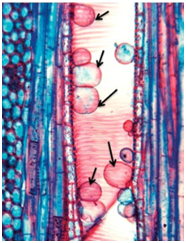The diagram shows the development of lateral roots. This development will be called as:

1. Exogenous
2. Endogenous
3. Exarch
4. Endarch

2. Endogenous
3. Exarch
4. Endarch
If you look at the section of a three year old eudicot stem, the vascular bundles will show:
| 1. | 3 rings of xylem and 3 of phloem. |
| 2. | 2 rings of xylem and 1 of phloem. |
| 3. | 2 rings of xylem and 3 of phloem. |
| 4. | 3 rings of xylem and 1 of phloem. |
Vascular bundles are continuous from the root to the stem, but different arrangements are found in two cases. What would be true for this arrangement?
| 1. | In the stem they are collateral with endarch xylem while in the root they are radial with exarch xylem |
| 2. | In the stem they are collateral with exarch xylem while in the root they are radial with endarch xylem |
| 3. | In the stem they are radial with endarch xylem while in the root they are collateral with exarch xylem |
| 4. | In the stem they are radial with exarch xylem while in the root they are collateral with endarch xylem |
What type of vessels are you most likely to see in metaxylem of a stem?
| 1. |  |
2. |  |
| 3. |  |
4. |  |
In the given diagram if xylem is represented by 1, the companion cells will be represented by:
1. 2
2. 3
3. 4
4. 5
In the section of a monocot leaf shown in the given diagram, what would be true for the structures labeled X?
| 1. | They regulate the opening and closing of the stomata in the adaxial surface of the leaves |
| 2. | Due to presence of lignin in their walls they provide support to the leaf surface in windy conditions |
| 3. | They are involved in folding and unfolding of leaf tissue to control light intensity and reduce overall water loss |
| 4. | They are abnormal cells produced during healing of the adaxial surface after injury and are common portals of entry of viruses into the plants |
The balloon like structures seen in vessels in the given diagram are called as:

1. Tyloses
2. Hydathodes
3. P proteins
4. Lenticells
Identify the correct statement regarding A and B [types of concentric vascular bundles] in the given diagram:
| 1. | A is Amphivasal and found in Dracaena while B is amphicribal and found in Selaginella |
| 2. | A is Amphivasal and found in Selaginella while B is amphicribal and found in Dracaena |
| 3. | A is Amphicribal and found in Dracaena while B is amphivasal and found in Selaginella |
| 4. | A is Amphicribal and found in Selaginella while B is amphivasal and found in Dracaena |
The given diagram shows the central core of root in a certain plant. P is phloem and protoxylem elements and V is metaxylem. What is correct for structures indicated by arrows?
| 1. | They show aerenchyma essential for aeration of root cells |
| 2. | They show cells in the roots that contain chloroplast |
| 3. | They show cells lack the characteristic radial and inner tangential wall thickening which is common to endodermal cells |
| 4. | They show cells that store resins and oils in the roots |
Consider the given two statements:
| I. | Vessel elements are generally thought to be more efficient conductors of water than the tracheids. |
| II. | Vessel elements, with their open systems, are more safe for plants than tracheids. |
1. Both I and II are correct and II explains I
2. Both I and II are correct but II does not explain I
3. I is true but II is false
4. Both I and II are false









